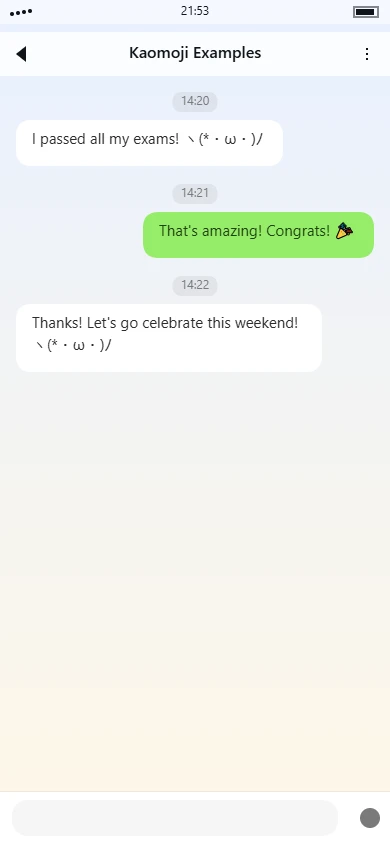(≧◡≦) kaomoji meaning | usage tips

Overview
The kaomoji (≧◡≦) presents a stylized facial expression using a combination of parentheses and mathematical symbols to create a cheerful, closed-eye smile. The overall structure consists of two symmetrical eye components flanking a central mouth element, all enclosed within outer parentheses that suggest the shape of a face. This arrangement produces a balanced, rounded appearance that conveys happiness through its upward-curving elements.
Symbol Breakdown
- Outer parentheses ( ): These brackets frame the entire expression, creating a circular face shape that contains the facial features within a defined boundary
- Eyes (≧ and ≦): The symbols ≧ and ≦ function as closed, smiling eyes. These are mathematical inequality signs (greater-than-or-equal and less-than-or-equal) that visually resemble eyes squeezed shut in happiness, with the curved portions suggesting the upward pull of smiling muscles
- Mouth (◡): The central ◡ character represents a smiling mouth with its upward-curving arc. This symbol creates the impression of a broad, genuine smile that complements the closed-eye expression
- Spatial arrangement: The tight grouping of elements without spacing creates a cohesive facial expression where all components work together to convey the emotion
- Symmetry: The mirrored placement of ≧ on the left and ≦ on the right creates visual balance, enhancing the expression's harmonious quality
Emotion & Aesthetic Analysis
This kaomoji primarily expresses cheerful contentment and genuine happiness. The closed eyes suggest a level of emotional intensity—the kind of happiness that makes one instinctively shut their eyes while smiling broadly. The expression carries a slightly more emphatic quality than simple smiling kaomoji with open eyes, indicating a deeper or more heartfelt positive emotion.
In terms of usage context, this kaomoji often appears in situations describing personal satisfaction, pleasant surprises, or heartfelt gratitude. It works well for expressing genuine appreciation or sharing positive personal experiences. Compared to similar kaomoji, the closed-eye aspect differentiates it from open-eyed happy expressions, giving it a slightly more intimate and less outwardly directed quality. The mathematical symbols contribute to a slightly technical aesthetic while maintaining approachability through their curved forms.
Tag categories
Use tags to quickly understand this kaomoji.
Usage guide
Usage Guide for (≧◡≦)
The kaomoji (≧◡≦) is one of the most versatile and widely used emoticons in digital communication, representing a cheerful, happy face with closed eyes and a broad smile. This expression conveys genuine happiness, contentment, and playful delight, making it perfect for casual conversations where you want to show you're in a good mood without being overly exaggerated. The closed eyes suggest a sense of comfort and satisfaction, while the upward-curving mouth indicates pure joy. You'll often see this kaomoji in friendly chats, social media comments, gaming communities, and casual work messages where the tone is lighthearted.
What makes (≧◡≦) particularly useful is its ability to express warmth without being too intense—it's more subtle than something like (ノ◕ヮ◕)ノ*:・゚✧ but more expressive than a simple :) . It works well across various platforms from Discord and Twitter to messaging apps like WhatsApp and Telegram. The expression falls somewhere between "pleased" and "delighted," making it suitable for everything from acknowledging a small favor to celebrating good news with friends.
Common Use Cases
- Expressing gratitude when someone helps you with a task or gives you a compliment
- Reacting to cute animal photos or heartwarming stories shared in group chats
- Showing appreciation for a friend's joke or funny meme in online conversations
- Responding to good news from colleagues or family members in casual messaging
- Adding a friendly tone when asking for small favors in gaming communities
- Commenting on food pictures or travel photos to show you find them appealing
- Reacting to achievements or milestones shared by friends on social media
- Expressing satisfaction after completing a challenging task or project
- Creating a warm atmosphere when welcoming new members in online communities
- Softening requests or suggestions to make them sound more polite and friendly
- Showing you're enjoying a conversation without needing to use many words
- Reacting to nostalgic memories or throwback photos shared by friends
Example Conversations
-
Friend sharing good news Person A: I finally got the job offer! Person B: That's amazing! (≧◡≦) So happy for you!
-
Casual work chat Colleague: I finished the report early if you want to review it You: Thanks! (≧◡≦) I'll take a look this afternoon
-
Gaming community Player 1: Anyone want to team up for the raid? Player 2: I'm in! (≧◡≦) What time works for everyone?
-
Social media interaction Post: Just adopted this cute puppy! Comment: Aww, so adorable! (≧◡≦) What's their name?
-
Family group chat Sister: Made cookies for everyone, come get some! You: On my way! (≧◡≦) Save me the chocolate chip ones!
-
Online shopping discussion Friend: That jacket looks great on you! You: Thanks! (≧◡≦) It was on sale too
Important Notes
- Avoid using (≧◡≦) in formal emails, professional correspondence, or serious discussions where a more professional tone is required. The playful nature might come across as unprofessional in business contexts.
- Be mindful that the expression can sometimes be interpreted as slightly childish or overly cute depending on your relationship with the recipient. It's generally safest with friends, close colleagues, or in casual online communities.
- In some cultural contexts, particularly in more reserved communication styles, this level of expressiveness might be seen as too emotional. When communicating with international contacts, gauge their communication style first.
While (≧◡≦) works well across most casual digital platforms, it's particularly common in anime/manga communities, gaming chats, and among younger demographics. Older users might be less familiar with this specific kaomoji format, so consider your audience when using it.
Usage examples
Real conversation samples that feature this kaomoji.

Example 1

Example 2
Related kaomoji
You might also enjoy these kaomoji.